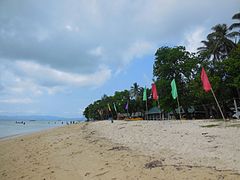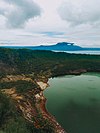
Calabarzon, sometimes referred to as Southern Tagalog and designated as Region IV‑A, is an administrative region in the Philippines. The region comprises five provinces: Batangas, Cavite, Laguna, Quezon, and Rizal; and one highly urbanized city, Lucena. It is the most populous region in the Philippines according to the Philippine Statistics Authority (PSA), having over 16.1 million inhabitants in 2020, and is also the country's second most densely populated after the National Capital Region. It is situated southeast of Metro Manila, and is bordered by Manila Bay to the west, Lamon Bay and the Bicol Region to the east, Tayabas Bay and the Sibuyan Sea to the south, and Central Luzon to the north. It is home to places like Mount Makiling near Los Baños, Laguna, and Taal Volcano in Batangas.

Pagbilao, officially the Municipality of Pagbilao, is a 1st class municipality in the province of Quezon, Philippines. According to the 2020 census, it has a population of 78,700 people.

Candelaria, officially the Municipality of Candelaria, is a 1st class municipality in the province of Quezon, Philippines. According to the 2020 census, it has a population of 137,881 people.

Balanga, officially the City of Balanga, is a 4th class component city and capital of the province of Bataan, Philippines. It is south of San Fernando, Pampanga and northwest of Manila. According to the 2020 census, it has a population of 104,173 people. Balanga joined the UNESCO Global Network of Learning Cities in 2015.

Infanta, officially the Municipality of Infanta, is a 1st class municipality in the province of Quezon, Philippines. According to the 2020 census, it has a population of 76,186 people.
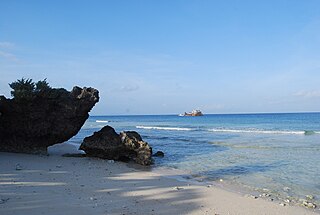
Polillo, officially the Municipality of Polillo, is a 3rd class municipality in the province of Quezon, Philippines. According to the 2020 census, it has a population of 31,908 people.

Sariaya, officially the Municipality of Sariaya, is a 1st class municipality in the province of Quezon, Philippines. According to the 2020 census, it has a population of 161,868 people.

San Remigio, officially called the Municipality of San Remigio, is a 3rd class municipality in the province of Cebu, Philippines. According to the 2020 census, it has a population of 65,744 people.

Samal, officially the Island Garden City of Samal is a 4th class component city in the province of Davao del Norte, Philippines. According to the 2020 census, it has a population of 116,771 people.
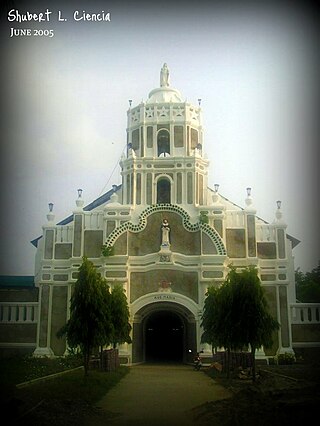
Santo Domingo, officially the Municipality of Santo Domingo, is a 3rd class municipality in the province of Ilocos Sur, Philippines. According to the 2020 census, it has a population of 29,041 people.

Capalonga, officially the Municipality of Capalonga, is a 3rd class municipality in the province of Camarines Norte, Philippines. According to the 2020 census, it has a population of 36,223 people.

Jose Panganiban, officially the Municipality of Jose Panganiban, is a 2nd class municipality in the province of Camarines Norte, Philippines. According to the 2020 census, it has a population of 63,662 people.

Boac, officially the Municipality of Boac, is a 1st class municipality and capital of the province of Marinduque, Philippines. According to the 2020 census, it has a population of 57,283 people making the most populous town in Marinduque.

Esperanza, officially the Municipality of Esperanza, is a 5th class municipality in the province of Masbate, Philippines. According to the 2020 census, it has a population of 17,534 people.

Sindangan, officially the Municipality of Sindangan, is a 1st class municipality in the province of Zamboanga del Norte, Philippines. According to the 2020 census, it has a population of 103,952 people.

Guinayangan, officially the Municipality of Guinayangan, is a 3rd class municipality in the province of Quezon, Philippines. According to the 2020 census, it has a population of 44,045 people.

In early Philippine history, barangay is the term historically used by scholars to describe the complex sociopolitical units which were the dominant organizational pattern among the various peoples of the Philippine archipelago in the period immediately before the arrival of European colonizers. Academics refer to these settlements using the technical term "polity", but they are usually simply called "barangays."
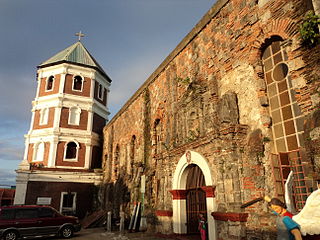
Atimonan, officially the Municipality of Atimonan, is a 1st class municipality in the province of Quezon, Philippines. According to the 2020 census, it has a population of 64,260 people.




